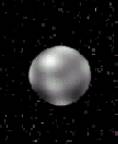
|| Sun || Mercury || Venus || Earth || Mars || Jupiter || Saturn || Uranus || Pluto ||
|| Home || Aliens|| Quiz || Glossary || UFOs || Universe || Space Craft || Satellites ||

Discovered in 1930, Pluto has always appeared as nothing more than a dot of light in even the largest earth-based telescopes because Pluto's disk is much smaller than can be resolved from beneath the Earth's turbulent atmosphere. Pluto is 2/3 the size of Earth's Moon but 12,000 times farther away
Taking 248 years to orbit the Sun, Pluto is the smallest and most distant planet from the Sun. Its diameter is only about two-thirds that of our Moon's. Pluto is sometimes considered a double planet system because its moon, Charon, is about half Pluto's size, making Charon the largest satellite in the solar system in proportion to the size of its planet.This distant planet is the only one in our solar system yet to be visited by spacecraft, but NASA is exploring the possibility of such a mission.
| Mean Distance from Sun | 5,906,376,200 km (3.67 x 109 miles) or 39.48 astronomical units |
| Diameter | 2,390 km (1,485.08 miles) |
| Volume (Earth = 1) | 0.005 |
| Mass | 1.29 x 1022 kg (0.00046 x 1027 ounces) or 0.0025 (Earth = 1) |
| Density | 1.1 gm/cm3 |
| Surface gravity | 0.066 (Earth = 1) |
| Rotation period (length of day in Earth days) | 6.39 (spins backwards compared to most other planets) |
| Revolution period (length of year) | 248 Earth Years |
| Mean surface temperature | -215.35 C (-355.63° F) |
| Natural satellites | Charon |
|| Our Solar System ||
|| Sun || Mercury || Venus || Earth || Mars || Jupiter || Saturn || Uranus || Neptune ||
|| Home || Aliens|| Quiz || Glossary || UFOs || Universe || Space Craft || Satellites ||